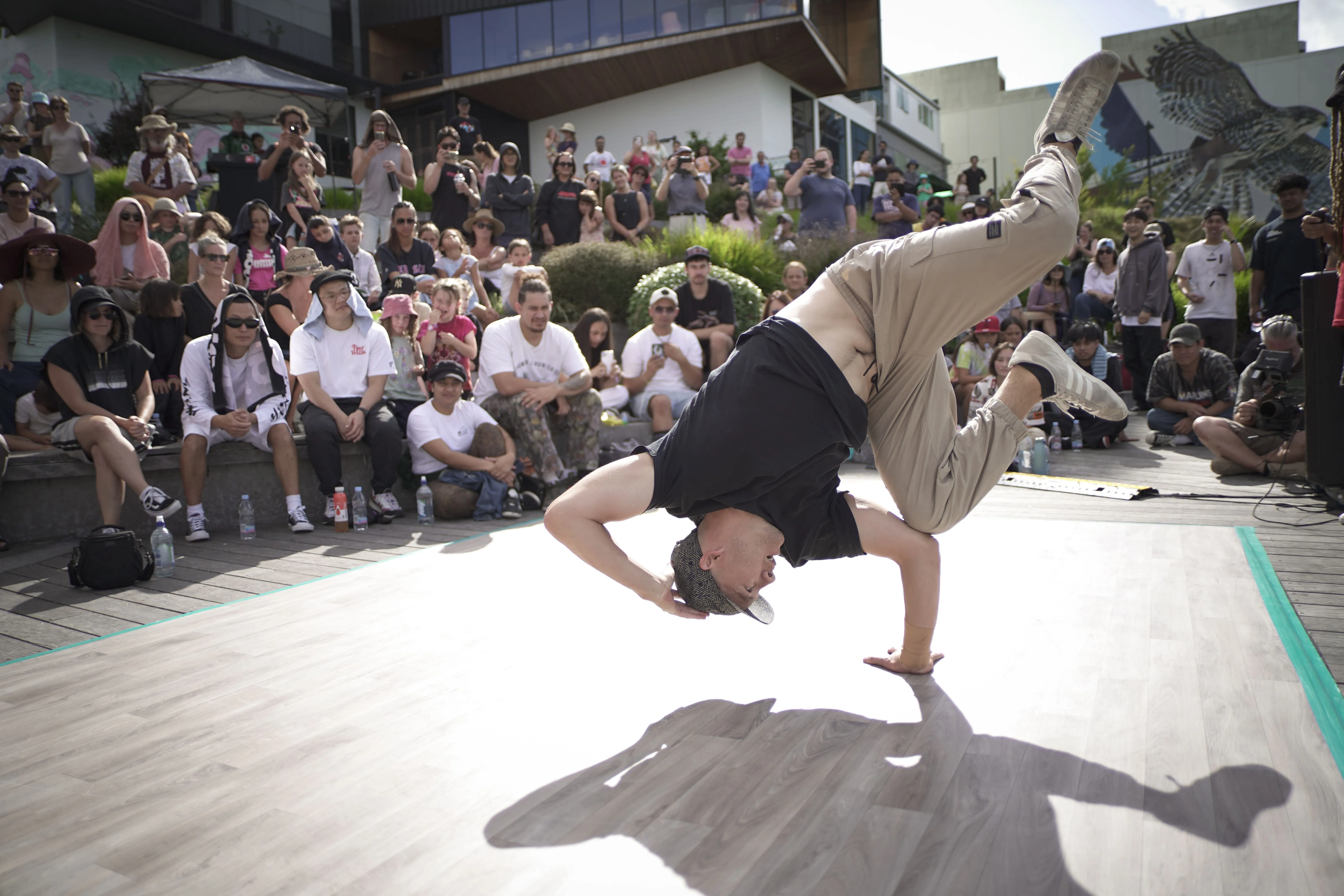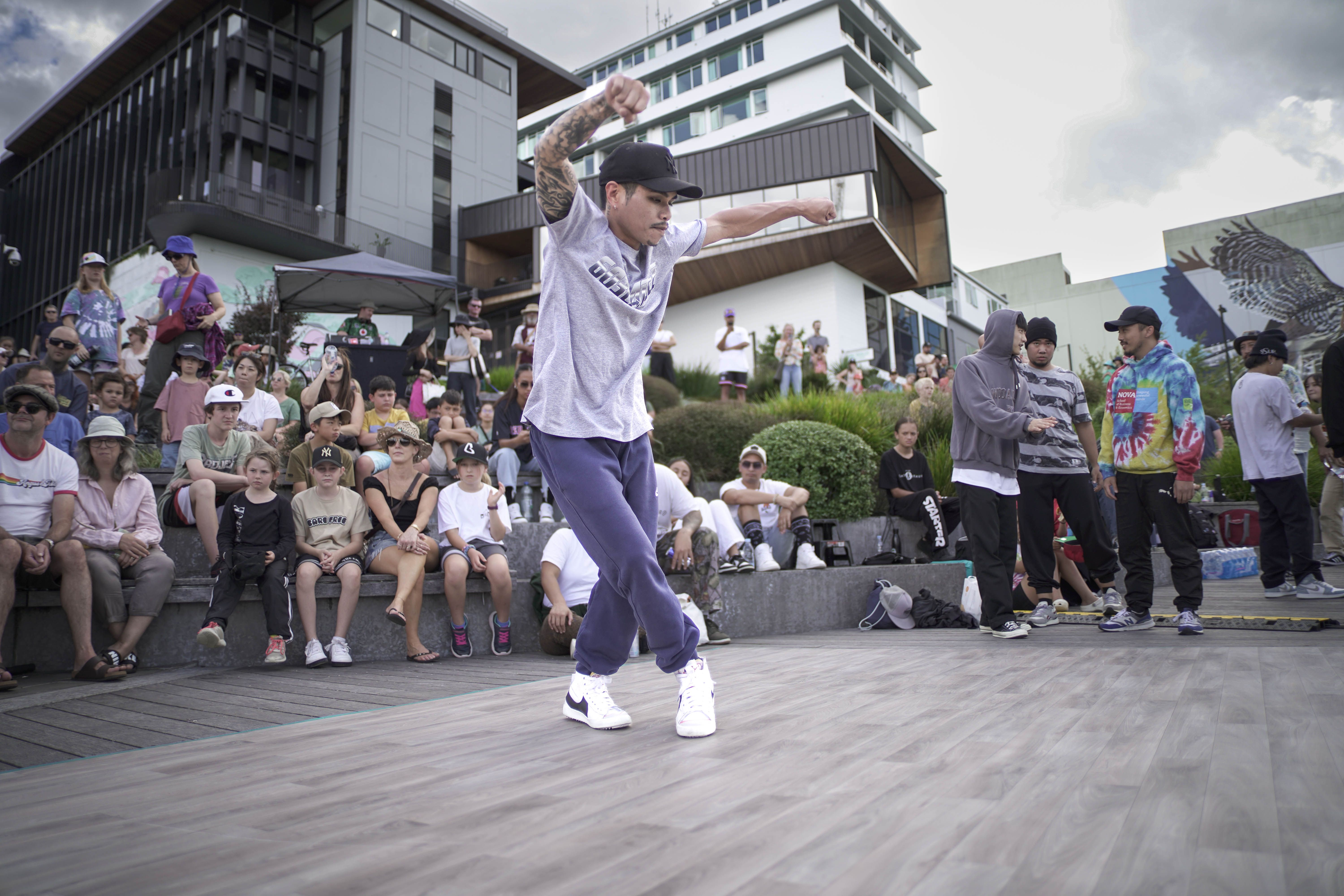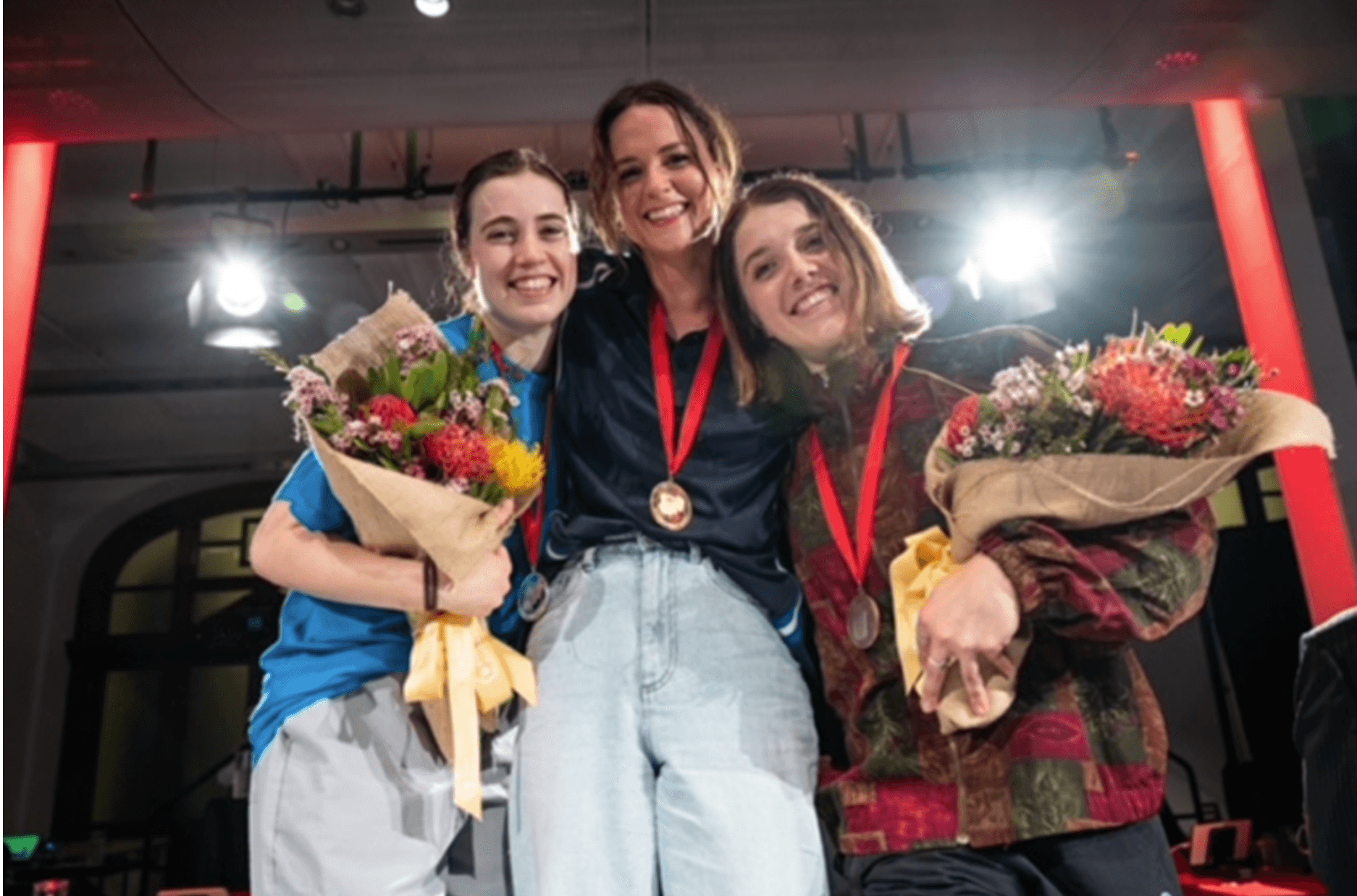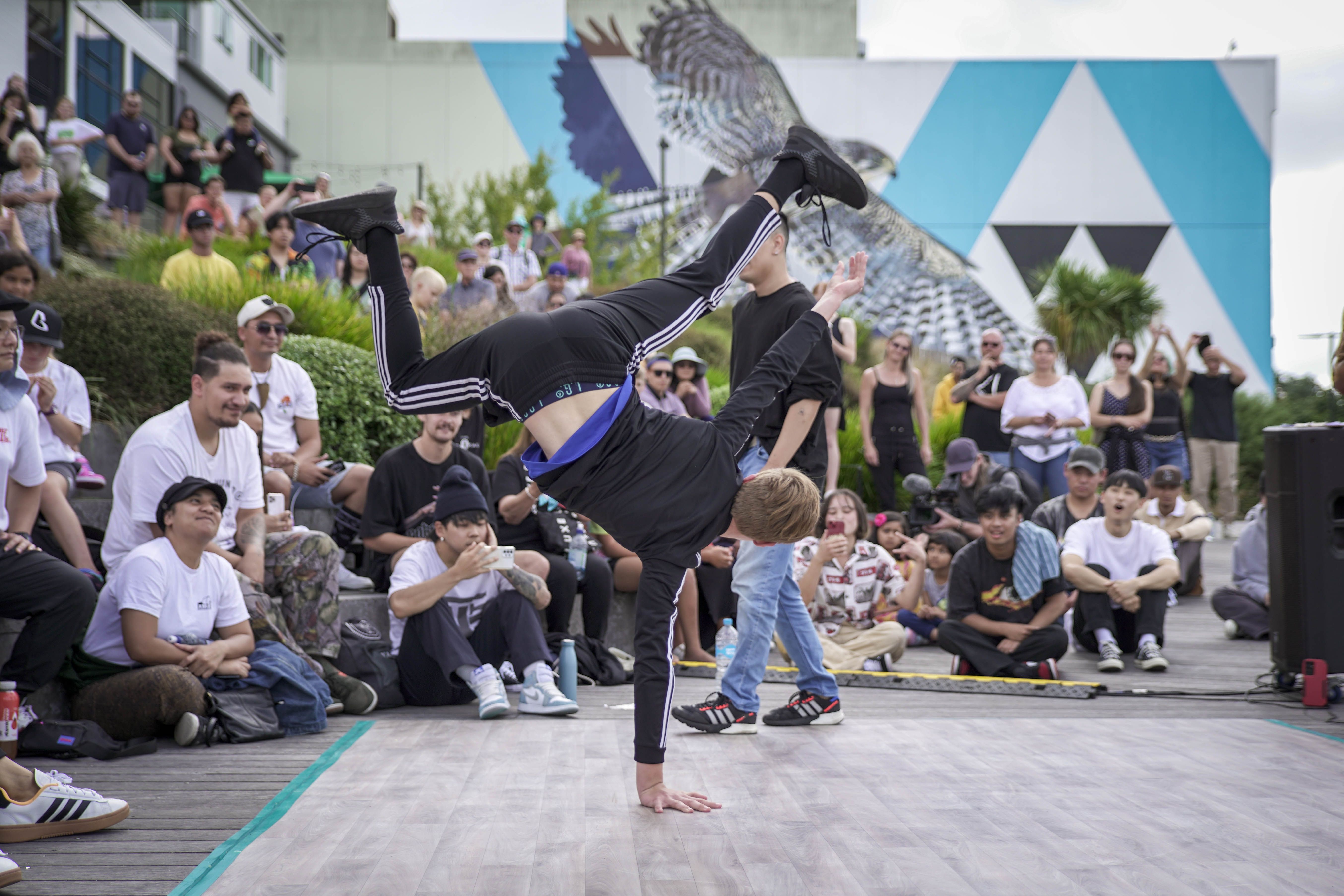OPINION: The Real State Of Breaking In Aotearoa
The performance and debate around Raygun overtook Breaking's Olympic debut. Dujon Cullingford - an Oceania Breaking leader - explains where the art form is at in the part of the world and breaks down the backlash.

We’ve all seen the memes about Raygun at the Paris 2024 Olympics.
Raygun’s performance has taken the world by storm, whether that’s a good or bad thing for the Oceania Breaking community, is arguable. Now that Breaking at Paris Olympics 2024 is done and dusted, and everyone online is a Breaking expert, I thought I would answer some of the FAQs from a ‘down-under’ perspective.
As a co-lead for our Aotearoa NZ Breaking Team and with 25 years experience in our Breaking scene, I'd rather address these topics head-on than leave it to people outside of our dance community who have no knowledge on how Breaking is judged at the Olympics, the Oceania selection process, and Breaking technicalities.
I've read some wild generalisations and hugely incorrect information from people and media outlets who have trivialised issues to supplement their lack of understanding.
Understanding the origins
First off, the Breaking community calls this dance ‘Breaking’.
’Break-dancing’ is a term that became synonymous with the dance during the global media wave of the early 80’s. The individual West Coast dance styles of Locking, and various Popping styles were lumped under the same umbrella incorrectly.
The term ‘Breaking’ is from the Breaking community, and a B-boy, B-girl or Breaker are appropriate terms of use for a dancer. ‘Breaking’ is derived from ‘the Break,’ the climactic part of a Funk song where the instruments dropped out, leaving room for the drums or rhythm section to break down. This was also the breaking point of the party and the most opportune time for dancers to throw down after socialising. James Brown's Funky Drummer is a great example of a prime song with a great break.

Like most countries, Breaking entered into Oceania in the early 80’s and it was received by thousands of very enthusiastic youth. It has been here since.
Unfortunately though, we suffer from an 80’s stereotype hangover where the public think spinning on our back is the only thing we do.
Breaking has evolved so much! With international competitions happening for over three decades, and a phenomenal amount of dancers around the world, many of us see the provisional entrance of Breaking into the Olympics as an opportunity for visibility and professional development.
The Olympic opportunity
Now, I get why people have such huge hot takes on Raygun’s performance.
Most people in the public know little about Breaking so it's easier to have an algorithm orgy about Raygun than to dig deep and understand the gigantic effort that thousands of B-boys and B-girls put in to get our dance to the Olympics, and celebrate the incredible skill and artistry that was on display to a global audience for over two days from the dancers.
What an absolute joy it was for us participants of the dance and Hip-Hop culture to see Breaking on the world stage and in full glory! If you haven’t actually watched any battles from the Paris Olympics, please do.
At the end of the day, most people talking about Breaking are not that interested in it.
It's the social media buzz topic of the moment, but I know this buzz is spilling over into actual interest with many commenters online saying they are watching the battles from the Paris Olympics after engaging in Raygun content.
This is why I would like to provide some clarity. So, here’s my response to the most frequently asked questions:
FAQ #1 - Breaking is not a sport!
We are a dance and a sport!
The correct and official term is ‘dancesport’. We maintain the artistic integrity of the dance and honour the physical challenge of the sport.
FAQ #2 - How did Raygun get to the Olympics?
In October 2023, the Oceania Champs took place in Sydney, Australia. This was a continental qualifier which gave the male and female winners direct qualification to the Paris Olympics.
The ‘runner-ups’ were allowed to compete in Shanghai and Budapest against the top 40 breakers in the world towards selection for the Paris Olympics.
There was a call out a few months prior for breakers around Oceania. Word gets around quickly when you are a competitive Breaker. You needed to register, be in Sydney for the competition, then compete! Breakers needed to throw down a strong round on the day to make it through the prelims, then progress on to 1-vs-1 battles. Raygun made it through the prelims and successfully beat the other B-girls in several battles to take the top spot.

There is no room for selection bias at Oceania Champs, or insider special treatment as suggested by some of the public.
The battles are strictly skill-based and the decision-making process is completely outsourced to a strict panel of nine international judges who judge each battle across the five criteria until a champion emerges.
Another theory I've heard multiple times is that Raygun’s husband was on the judging panel for Oceania Champs. This is false. You can see the judging line up here. In fact, you can fact-check the qualification process with the Australian Olympic Committee’s details on the qualifier here.
This puts to rest a lot of theories which entertain the idea that Raygun was ‘picked’ because of her professional standing or relationship with the Australian Breaking organisation, or she manufactured the line-up. You can’t even get picked if you wanted to.
FAQ #3 - So Raygun beat New Zealanders at the Oceania Champs?
Yup. We took a team, that was mostly male, from Aotearoa to the Oceania Champs.
We happen to be in a time here in NZ where many of our top B-girls have retired or are now inactive. Our top-ranking NZ B-girl withdrew from the competition so we scrambled to backfill positions.
We had two of our B-girls who had literally just had babies, Hayley Ng AKA B-girl H, and Shang-Ting Wu aka B-girl TnT. I spent a few hours at the Oceania Championship holding one of the babies in the backroom while they competed.
The public seem to think because Aotearoa has an outstanding record in Hip-Hop dance on the global stage that the Breaking community must be in the same zone.
Hip-Hop and Breaking are different dance forms with very different infrastructures, backing and support behind them. The NZ Breaking scene is small.
FAQ #4 - Why was the skill level of Oceania lower than the rest of the world?
Breaking participation is low in Oceania.
It is easier to finger-point at Raygun’s performance than find out what led us to the lack of B-girls competing down here. It is a topic for another day, because it is complex, multi-generational and explores a variety of factors in our community.
We have some absolutely incredible B-boys and B-girls, but until we invest serious resources into the dancesport, we will not see the infrastructure needed to support our dancers to flourish on the world stage. Side note: there are some experienced B-girls from Aotearoa and Australia that did not enter the Oceania champs.
FAQ #5 - Cultural appropriation
This is specifically about the qualification process and her movement. Since writing this, there are a range of other talking points under this banner.
It seems Raygun has become a scapegoat for a range of conflating issues. A few theories suggest Raygun’s academic standing and white privilege bought her the ticket to Paris. As I have addressed above, that is too far-fetched given that the qualifier is a strictly skills-based competition.
I understand that seeing a traditionally black American artform become a joke online following Raygun’s performance would have been triggering for many. Raygun just happened to compete in the weakest continental qualifier in the world and win. Folks need to get familiar with our Breaking scene before writing a thesis, particularly the need to reckon with the Breaking skills-gap between our region and others, and the historical factors that contribute to this problem.
I can only assume under this theory, that the other middle-class dancers are under the same scrutiny from the public that they used their power to gain entrance?
Some people think she is deliberately mocking the dance, and this is the source of their criticism about entitlement and gentrification on the world stage. Some think she intentionally threw her rounds in an exercise of rebellion against the Olympics structure. I don’t believe either. I have seen her compete before, her performance is very consistent with her skill level.
As for the other arguments about cultural appropriation, there are strong black voices on both sides of the fence. I have taken my leaf from the book of strong black voices within dance, including Buddha Stretch (NY) and DJ Renegade (UK) who co-created the judging system for Olympic Breaking. They have consistently echoed many of the same sentiments, read my very article here word-for-word to a global audience, and their Instagram live is full of gems and insights.
FAQ #6 - Skills
As for her actual performance at the Olympics, it may not have been a strong performance compared to the rest of the dancers, but that was to be expected from our region based on the turn-out at Oceania Champs.
People have been really confused by Raygun’s Breaking style, but most of these critics haven’t danced in a battle and it shows!
She simply did not have the speed or finesse required to execute her movements at a high skill level so the sharp lines, swift combos and contrasting movements required to deliver an impact performance looked considerably more sluggish than the other competitors. The gesturing and characterisation which is a normal part of Breaking was marred by the lack of execution, and isolated for meme content.
If a high level B-girl executed Raygun's choreography at speed, and sprinkled some strength moves in between, no one would even bat an eyelid!
As a solution, B-boy Fongo, the coach of J-Attack (the Australian B-boy) suggested a global benchmark score should be implemented in the regional qualifier stage. So, if a winner does not meet the minimum world requirement, they could be redirected into further global qualifying battles for improvement instead of direct qualification to Olympics. This would majorly help with quality control and expectation management of spectators.
FAQ #7 - Where to from here?

If just a fraction of the people invested in talking about Breaking online invested their time in attending local Breaking events in Aotearoa, we would actually have enough revenue to fund mentoring, training and better competitions.
The dance has just transitioned into a dancesport, and our human resources only stretch so far. Our dance is almost completely reliant on volunteering, with leaders giving hundreds and even thousands of hours to mentoring, training, and nurturing individuals and crews in New Zealand.
Much like other small sports, we do our best but acknowledge that without resources, we are running uphill against countries who have full time B-boys and B-girls, and see major sponsorships behind dancers and competitions.
Breaking completely changed my life.
As a 12-year old, the Breaking community took me in and a whole world of movement, culture and community opened up. I’m forever thankful that Breaking allowed me to partake in the dance, and nurture a life of creativity.
The dance community is like a family and after 25 years of joy, it is a pleasure to see others experience this joy, like my 9-year old daughter who is a strong upcoming B-girl. I hope when she is ready to compete, we have an infrastructure that can support our B-girls to flourish on the Olympic stage.
Watching Breaking at the Olympics was incredibly uplifting. The two days of competition had my family on the couch, glued to the screen, nodding our head to funk music and admiring the skills of all the competitors. This is the Breaking we fell in love with, and we hope you do too.